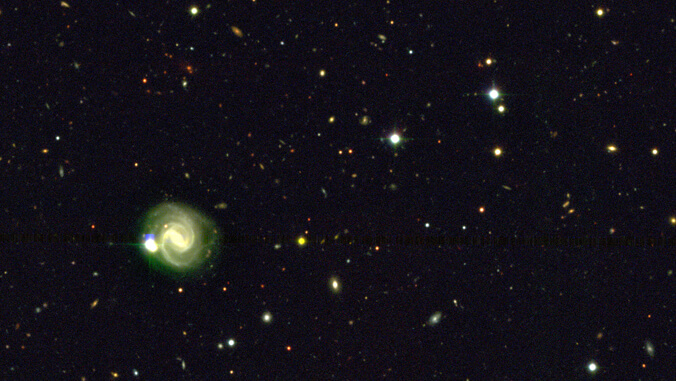
Observing billions of galaxies across more than a third of the sky and building a 3D map of the universe are all part of the Euclid mission that the European Space Agency launched with its Euclid satellite from Cape Canaveral, Florida. Euclid’s dataset is getting a big helping hand from observations taken at three observatories in Hawaiʻi.
The Euclid satellite mission will spend more than six years in space and involve more than 2,000 scientists, including astronomers in Hawaiʻi. Unlike the James Webb Space Telescope, which observes a tiny portion of the universe in great detail, Euclid will survey a large portion of the sky, to see a massive section of the universe.
Prior to Euclid’s launch, the work of creating the map began in Hawaiʻi through the UNIONS project, an ambitious imaging survey of the northern sky in the optical and near-infrared conducted by three Hawaiʻi-based telescopes since 2017: the Canada-France-Hawaiʻi Telescope (CFHT), Japan’s Subaru Telescope on Maunakea, and the University of Hawaiʻi Institute for Astronomy (IfA) Pan-STARRS telescope on Haleakalā, Maui.
UNIONS is co-led by Jean-Charles Cuillandre of CEA Saclay/Université Paris-Saclay, along with Ken Chambers at IfA, Alan McConnachie at Dominion Astrophysical Observatory (DAO) in Canada, Oguri Masamune at Chiba University in Japan, and Mike Hudson at the University of Waterloo in Canada.
“The superb observing conditions in Hawaiʻi led to the unprecedented collection of galaxies over a very large area of the sky with each telescope playing a critical role by adding different filters or colors to the Euclid data,” said Cuillandre, a former CFHT staff astronomer. “While a critical part of the original motivation to obtain the UNIONS data was the Euclid mission, the data will have an impact extending far beyond the space mission.”
The IfA team is especially interested in using this data to measure the parameters that characterize the properties of the universe.
“The Euclid mission will provide a next generation measurement of these characteristics, and we may discover we have made a mistake or series of small mistakes along the way, or we may find that dark energy is more complicated than in Einstein’s formulation,” said Chambers. “Or there might be something else, some new aspect of the universe that we are presently unaware of.”
Hawaiʻi adds color
By observing more than one-third of the observable sky outside the Milky Way, Euclid will image billions of targets out to a distance of 10 billion light years. Astronomers estimate the distances to these galaxies—and thus convert 2D images to a 3D map of the universe—using their observed brightness in different color filters. The more filters are used, the better the distance estimate. But Euclid has only four filters—one that spans most of what we see as visible light, and three that cover infrared wavelengths, beyond what our eyes can see.
The Hawaiʻi telescopes will add observations in five visible-light filters, spanning the rainbow from the violet to far-red. In other words, the three Hawaiʻi telescopes turn the black and white 2D images from Euclid into a full color, 3D map of the universe. Because Euclid is mapping such a huge swath of sky, and ground-based telescopes have different capabilities, multiple observatories have to contribute to provide all the data.
“The idea for one filter from space and additional filters from ground-based telescopes was the Euclid plan from the beginning. Subaru observations add far-red and green, Pan-STARRS has been observing the sky for years searching for asteroids allowing a depth of red data, and CFHT adds blue, enhancing the one filter images that Euclid will produce,” said Professor Satoshi Miyazaki, director of Subaru Telescope. “UNIONS is a consortium of telescopes in Hawaiʻi, extending broader than just Euclid. UNIONS scientists are also sharing data to conduct research collaborations based on Hawaiʻi.”
Gravitational lensing
“Ultimately, data from the Hawaiʻi telescopes—CFHT, Subaru, and Pan-STARRS—will turn the images into a three-dimensional map of our Universe.”
Dark matter does not emit light like the more familiar planets, stars and galaxies. However, dark matter has gravity and can be detected by observing large clusters of galaxies. In some cases, the immense gravity of a galaxy or cluster of galaxies can bend light from an object behind it, known as gravitational lensing. Ground-based observations will assist astronomers working on the Euclid gravitational lensing project.
“I have worked on the Euclid mission for 12 years and it is very satisfying to see the mission launch,” said Jean-Gabriel Cuby, CFHT executive director and Euclid board member. “Much like with the James Webb Space Telescope, Euclid will surprise us and lead to insights we do not fully anticipate. Insights enabled by the efforts of the teams at CFHT, Subaru and Pan-STARRS.”
The first images from the Euclid mission are expected in around two months. Euclid will build up a large archive of unique data, unprecedented by volume for a space-based mission, enabling research over all disciplines in astronomy. The data will be archived at the Canadian Astronomy Data Center (CADC) and accessible to astronomers around the world. CADC will also provide color information based on the observations from the Hawaiʻi based telescopes.
“The Euclid images will be beautiful to look at, above and beyond the considerable scientific value of the data. I’m looking forward to seeing them,” said Stephen Gwyn, science data specialist at the Canadian Astronomy Data Centre. “Ultimately, data from the Hawaiʻi telescopes—CFHT, Subaru, and Pan-STARRS—will turn the images into a three-dimensional map of our Universe.”

